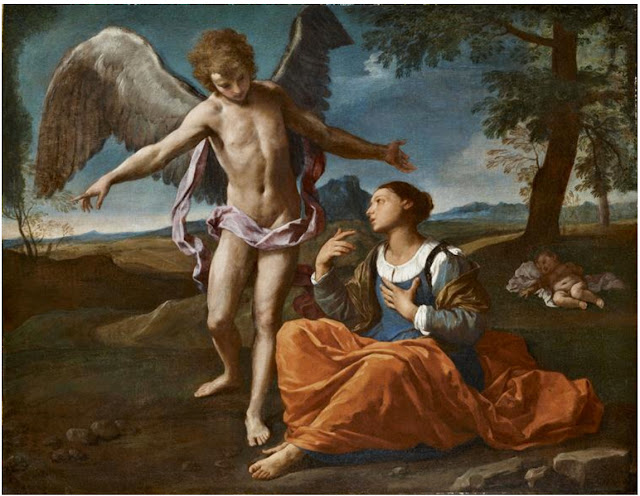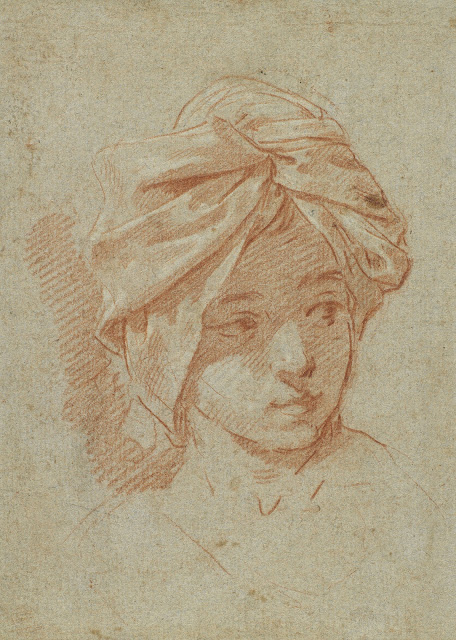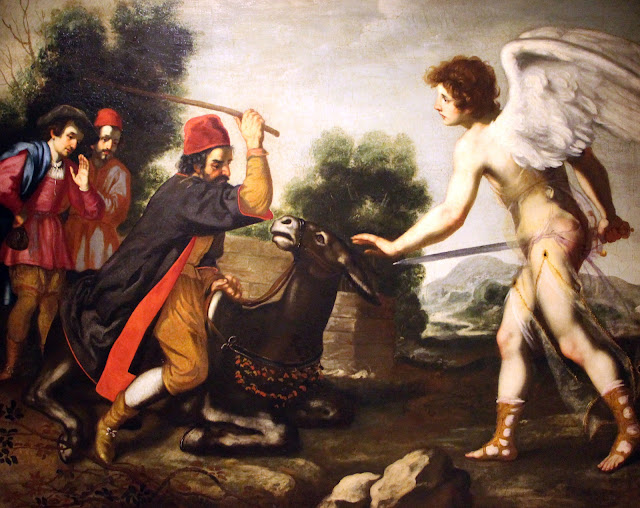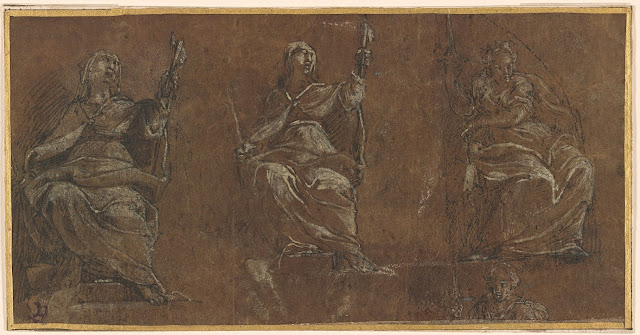 |
| Simone Cantarini Allegory of Painting ca. 1620-30 oil on canvas National Museum, Warsaw |
 |
| Simone Cantarini Holy Family with St John the Baptist offering Fruit ca. 1632-48 oil on canvas National Trust, Kedleston Hall, Derbyshire |
 |
| Simone Cantarini after Annibale Carracci Pietà ca. 1640 oil on alabaster El Escorial, Madrid |
"Simone Cantarini was born in 1612 in Pesaro, in the Marches. He began his artistic training quite young, probably 1623-25, in the studio of Giovanni Giacomo Pandolfi, a painter of religious works who combined the local naturalism with the Mannerist style of the late sixteenth century. After a brief trip to Venice, Cantarini moved to the shop of Claudio Ridolfi, a student of Paolo Veronese. From Ridolfi he received training in the Venetian manner that was also a strong current in local tradition, as well as a deep appreciation for the work of Federico Barocci, with whom Ridolfi had worked in Urbino. In about 1629 Ridolfi left Pesaro, forcing Cantarini to continue his studies on his own. In addition to prints by the Carracci, the young artist turned his attention increasingly to Barocci, and also to the Caravaggesque yet very personal art of Orazio Gentileschi. . . . As Malvasia recounts, the most significant event of Cantarini's youth was the arrival, probably in 1632, of Guido Reni's Madonna and Child with Saints Thomas and Jerome in Pesaro Cathedral. . . . The young artist quickly assimilated Guido's style and soon received important commissions. . . . Upon his arrival in Bologna, probably in 1634 or 1635, Cantarini presented himself in Guido's studio as a painter of little training. His abilities soon became evident. Although Guido recognized that Cantarini was already a fully formed painter, he made the young man his most trusted pupil and secured him many commissions. Eventually, however, Cantarini's infamous pride and unbridled tongue came to the fore and alienated the master and the entire studio. . . . In 1639 Cantarini is documented at his sister's wedding in Pesaro. It must have been shortly thereafter, in 1640 or 1641, that he made a brief trip to Rome. Following Guido's death in 1642, Cantarini returned to Bologna, where he maintained a successful studio until his death in 1648 following a stay in Mantua. His behavior and criticisms of the Gonzaga collection created a scandal and it is suspected that he was poisoned by an angry rival."
– from the artist's biography in the Systematic Catalogue of the National Gallery of Art, Washington DC
 |
| Simone Cantarini Risen Christ ca. 1644-48 oil on canvas Museum of Fine Arts, Boston |
 |
| Simone Cantarini Archangel Michael with Hagar and Ishmael in the Wilderness before 1648 oil on canvas Musée des Beaux-Arts de Pau |
 |
| Simone Cantarini Rest on the Flight into Egypt ca. 1640 oil on canvas Pinacoteca di Brera, Milan |
 |
| Simone Cantarini St John the Baptist in the Wilderness ca. 1640 oil on copper National Trust, Attingham Park, Shropshire |
 |
| Simone Cantarini Virgin of the Rose before 1648 oil on canvas Pinacoteca San Domenico, Fano |
 |
| Simone Cantarini Sibyl Reading ca. 1630-35 oil on canvas Banca Popolare dell' Adriatico, Pesaro |
 |
| attributed to Simone Cantarini Noli me tangere before 1648 oil on canvas Schleissheim State Gallery, Bavaria |
 |
| attributed to Simone Cantarini Doubting Thomas before 1648 oil on canvas Schleissheim State Gallery, Bavaria |
 |
| attributed to Simone Cantarini Head of Bearded Old Man before 1648 oil on canvas National Trust, Saltram House, Devon |
 |
| Simone Cantarini St Luke painting the Virgin before 1648 oil on canvas private collection |
 |
| Simone Cantarini The Holy Trinity ca. 1640-48 oil on canvas (unfinished) National Galleries of Scotland |
 |
| Simone Cantarini Holy Family ca. 1645 oil on canvas Museo del Prado, Madrid |









































